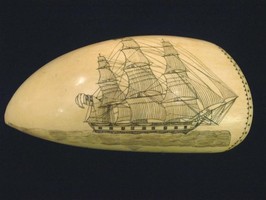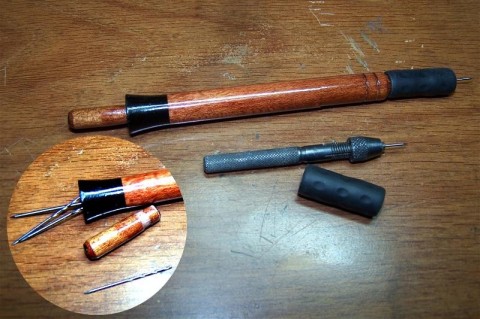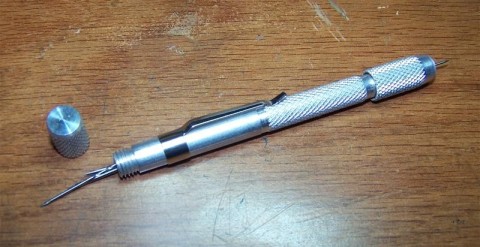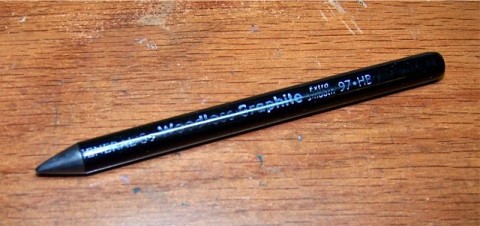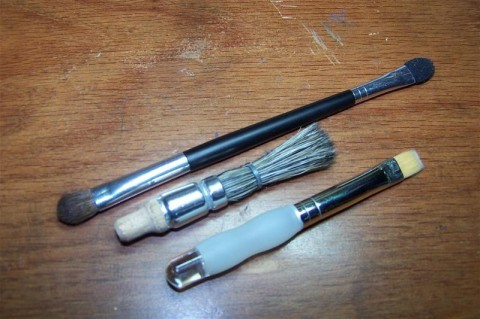Facts & Questions
What is Scrimshaw?
Two etymology sources define "scrimshaw" as meaning to "waste time" and to "shirk duty." Therefore a person who scrims or scrimshaws is a timewaster, one who shirks work.
Scrimshaw began as the art of etching pictures onto ivory or bone. During the 1800's sailors on the great whaling ships sailing out of Nantucket or Mystic Seaport and New Bedford would scratch scenes onto whale teeth in their free time after finishing their chores. Scratching the picture into the ivory they would then rub lamp black or tobacco juice into the etched lines to highlight the scene.
Can anyone scrimshaw?
Yes, anyone can scrimshaw. The real question I suspect is, "Can I make beautiful pictures and portraits too?"
I believe the answer to that is yes, but expect to pay your dues and spend countless hours practicing and making many mistakes before you become proficient. Do you want to stipple or do you prefer crosshatching or squiggly line work? Or perhaps a combination suits your taste in art. There are many techniques you can utilize and those are the things that every novice has to decide on and work at.
A good starting point would be to research pen & ink drawings and studying the techniques different artists use. One of my favorite artists is Claudia Nice. She has several instructional books out on composition, style, and technique from which I've learned a lot.
Ultimately remember this: it's all about the journey, not the destination. Have fun!
Isn't all ivory illegal?
No, not all ivory is illegal.
CITES, or Convention on International Trade in Endangered Species, provides laws and guidelines regarding the disposition of ivory. Fossil ivory and antique or pre-ban (1972) ivory is legal to own, sell, or trade within the confines of the United States.
I use antique, or old estate ivory which was imported into the United States before the restrictions on elephant ivory went into effect in 1972.
Purchasing, selling, or trading Mammoth, Mastodon, or pre-ban fossil Walrus ivory is completely unrestricted within the United States.
While both Mammoth & Mastodon ivory may be exported out of the United States and require no export permit, fossil Walrus does require an export permit.
What kind of ink is best?
I use several different kinds of inks. These range from the standard India Ink to Acryllic paints to Block Printers ink which is an oil-based ink. Each of these inks, while achieving virtually the same result, tend to "work" differently in their applications. For instance, the oil-based ink will fill the scratches and stippling just fine but takes longer to dry. Therefore wiping off this ink is very easy to do because it stays moist. The downside is it leaves a thin oily film which requires a little extra wiping. Doing so tends to pull the ink out of the scratches & stippling which means you will need to re-ink after it drys for a while - and a favorable dry time can be as little as 2 days up to a week.
Both India ink & Acryllic paint dry very quickly - within a few minutes. The excess is much harder to remove from the ivory. I've found that if I use a damp paper towel and moisten the surface slightly the excess comes off easier, however, it still takes time to clean up the ivory after application.
Acryllics produce a very nice color and the black (called Mars Black) is very dark. The Block Printers ink does not give me the same level of intensity as the Acryllic paint does.
Just recently I have begun experimenting with the Dr. Ph Martin watercolor products. They seem to do a good job and the colors are vibrant.
What kind of tools do you recommend?
In order to scrimshaw you will need some basic tools. They are:
- A scribe
- Magnification
- Stabillo pencil
- Brushes
- Acetone
- X-Acto knife with # 11 blade
- Paper towels
- Cotton cloth
A word on the last four items:
Acetone is not only handy for clean up but also for cleaning a polished piece of ivory in preparation to scrimshaw. Paper towels and soft cotton cloths are excellent for this purpose. They also make good applicators when applying ink and wiping off the excess.
An X-Acto knife is the preferred tool for many scrimshaw artists and is certainly worth trying out. When I first started scrimshawing I worked with an X-Acto but soon found that I had better luck with a needle and pin vise.
This is my main scribe tool. I made it by hand by hollowing out a piece of maple to accommodate a pin vise which holds a needle (right side). A pressure-fit wooden plug is supplied for the other end where I store extra needles. The needles I use are actually drill bits of various sizes which I have sharpened as you can see in the inset close-up picture.The actual pin vise is directly below the maple tube. A small rubber finger grip which I acquired from a ball point pen adds comfort to the barrel of the pin vise.
This is a small drill pin vise I purchased at Home Depot. It included several drill bits which I sharpened to a fine point. You can find similar pin vises like this at Lowes, hobby or art supply stores, and online. Notice the cap at the end with a storage compartment to secure your needles.
There are all kinds of magnifiers you can use. When I first started scrimshawing I used a desk top style light on a goose neck arm. It had a round florescent light positioned just underneath the magnification. Due to constantly smudging the lens with my nose and the fixture constantly wiggling I eventually switched to the jewelers loupe which I use almost exclusively today. The loupe fits on the temple arm of my glasses. Obviously this works well for people who wear glasses. If you don't wear glasses and you want to try a loupe you might consider a pair of non-prescription, clear lens glasses.
There are many options available but one of the better ones is the Opti-visor which is worn like a ball cap. The lens lowers down in front and is similar to looking through eye glasses. An Opti-visor can be worn with or without glasses and is a good alternative to a loupe.
Brushes are useful for gently brushing away debris off the ivory. Depending on how deep your etching is will cause varying degrees of flakes of ivory which you need to get rid of.
The top brush pictured above has a very soft bristle brush on one end and a harder bristle on the other. The middle brush is a paint brush and I cut the handle off to make it more manageble. I did the same with the bottom brush. It had a clear acryllic handle and after cutting it down to size I rounded it over and polished it out.

